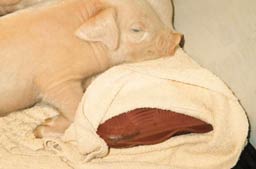From the Editor
What is good welfare on a pig farm?
For 15 years, Karen Richardson was a swine farm manager. You are unlikely to find another person more in tune with each individual pig on the farm. Not that Karen knew every single pig - but she certainly knew every pig that was not perfect. Karen has an eye for the pig that is not feeling 100% well. She is faster than most people at picking the one pig that needs attention out of a pen of 20 or 40 or 100. When she says "What about that fellow?" you would likely say "Oh, yes, now I see what you mean," but Karen found the pig first.
 Karen put the sick pen for the grower pigs in the part of the barn where she most
often walked. She had a turkey baster and a large bottle of oral electrolytes hanging on
the outside of the sick pen. Each time she walked past the pen, she leaned over
and fed the sick pigs a baster full of
electrolytes. Once, when we were doing a study of
providing maximum care to nursing pigs, Karen gave a litter of underweight pigs
a hot water bottle. She put the hot water bottle under the heat lamp and the
water stayed warm. When I asked her where the bottle came from, she said "My home."
As far as Karen is concerned, there is nothing too good for the pigs in her care.
Karen put the sick pen for the grower pigs in the part of the barn where she most
often walked. She had a turkey baster and a large bottle of oral electrolytes hanging on
the outside of the sick pen. Each time she walked past the pen, she leaned over
and fed the sick pigs a baster full of
electrolytes. Once, when we were doing a study of
providing maximum care to nursing pigs, Karen gave a litter of underweight pigs
a hot water bottle. She put the hot water bottle under the heat lamp and the
water stayed warm. When I asked her where the bottle came from, she said "My home."
As far as Karen is concerned, there is nothing too good for the pigs in her care.
I think that good welfare is personal attention to the individual pigs in the barn that need extra TLC (tender loving care). I also think that farm personnel who are enabled to give TLC to pigs needing care must feel a higher level of satisfaction with their work. It does not likely feel good to see a pig that needs care when you have been given restrictions that prevent the opportunity to provide care. Good welfare is not a matter of farm size: rather, it is a matter of providing TLC to the pigs that need it.
I am inspired by the study of Dr Morgan Morrow and his colleagues published in this issue of the Journal of Swine Health and Production. Their work itemized nursery pig problems, categorized mild, moderate, and severe forms of the problems, and assigned a welfare score to each category of each condition. These lists and descriptions can be used as education tools to improve welfare of the individual pig. The researchers also illustrated the welfare and economic costs involved when the nursery unit imposed conservative, moderate, or aggressive culling protocols, and depicted the balance of economic value of the pig with the welfare cost in a scatter plot. This was a strong visual depiction of the interaction between the positive aspect and the negative aspect of these compromised pigs. This work is scientifically sound and very practical. I think this work will serve to improve the welfare of pigs.
-- Cate Dewey
Thank you, ancillary editors
Drs Robyn Fleck, Rika Jolie, and James Kober have done a wonderful job as editors of What's Your Interpretation, Diagnostic Notes, and Practice Tips, respectively. The editorial board has decided not to include these non-refereed ancillary articles in each issue of the journal. The space freed up will be used for peer-reviewed manuscripts. If we receive submissions for the ancillary categories, Robyn, Rika, and James have graciously agreed to continue to edit them. When you next see these members, please join me in thanking them for their contributions to our journal..
-- Cate Dewey
